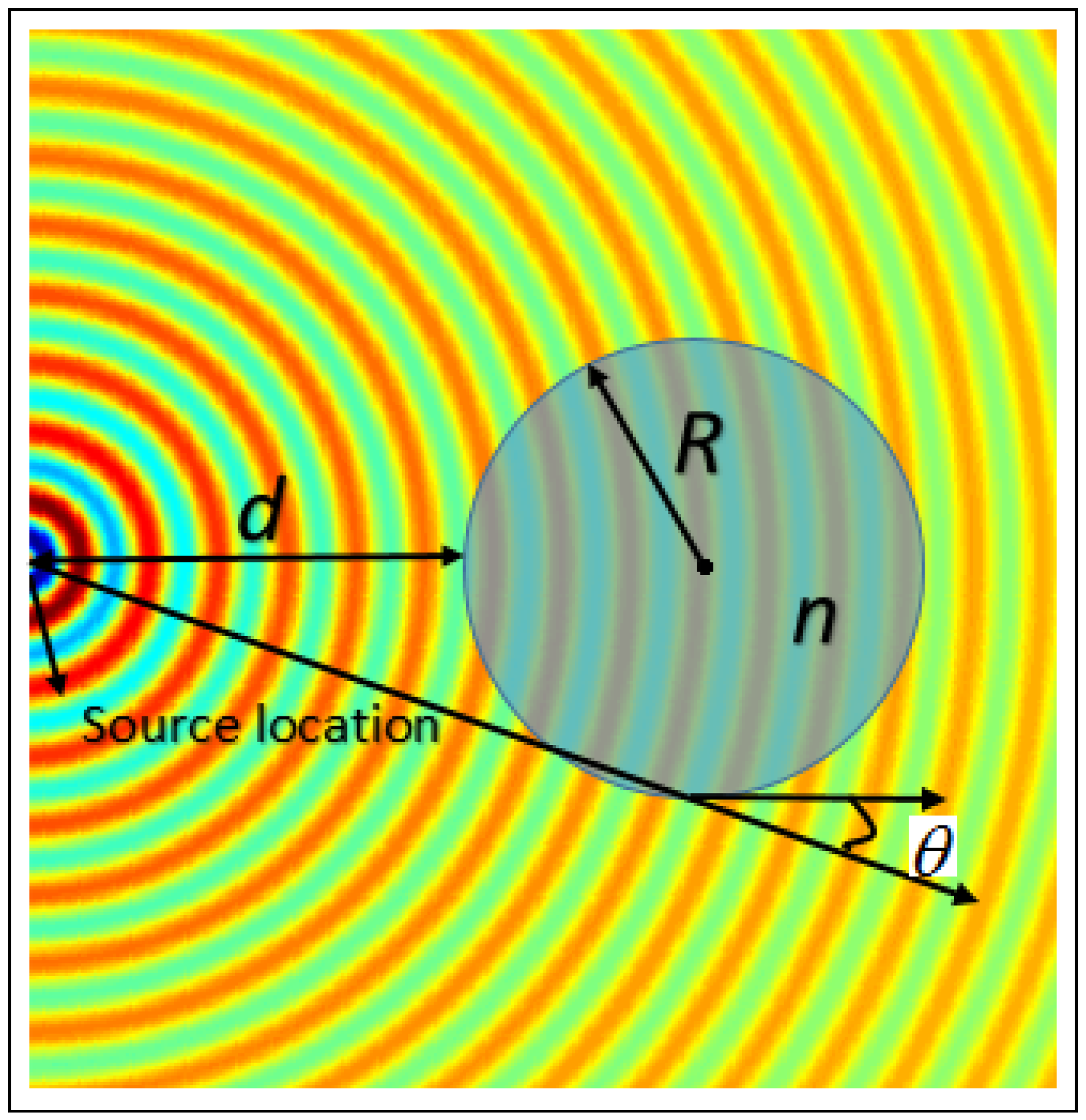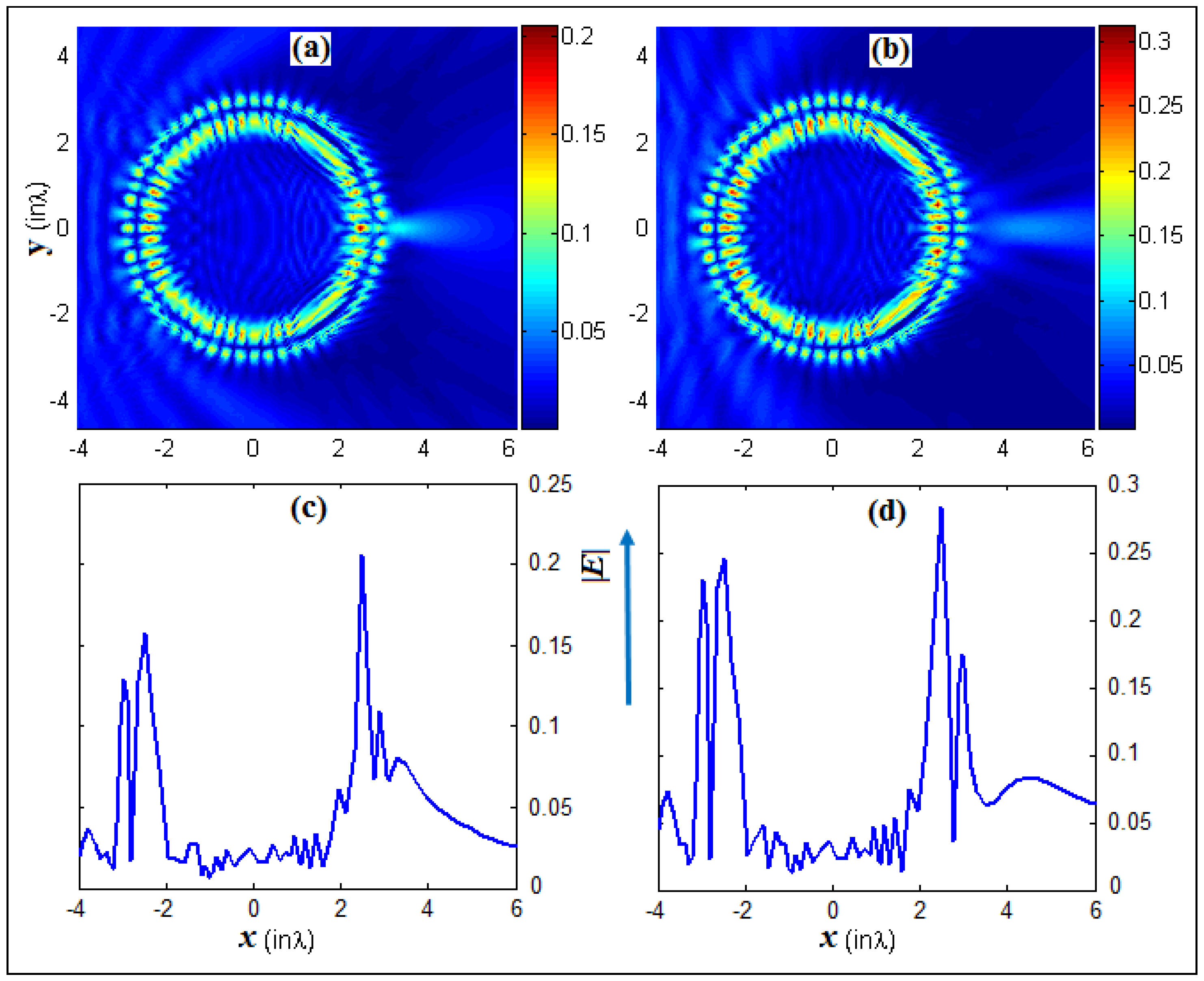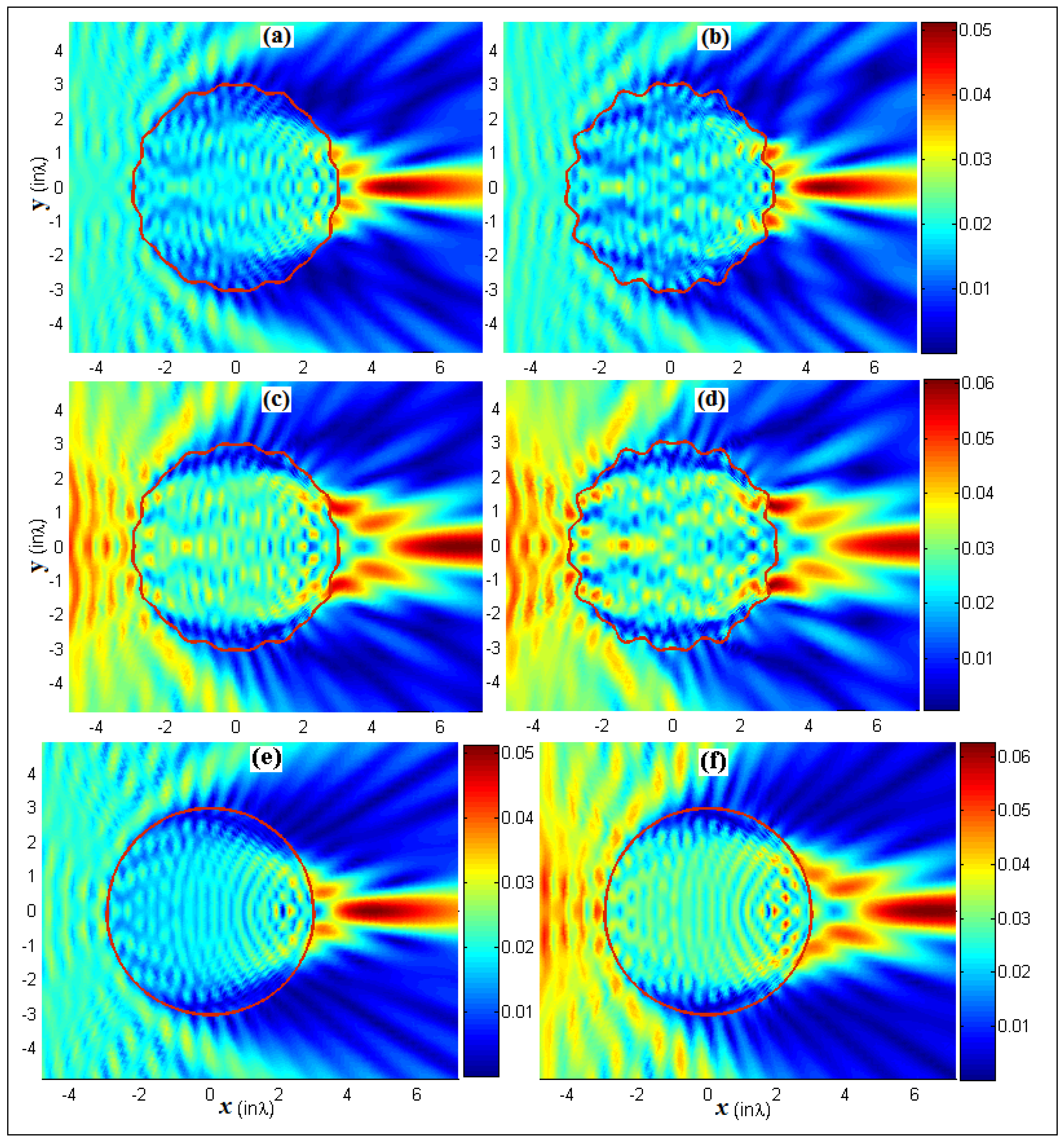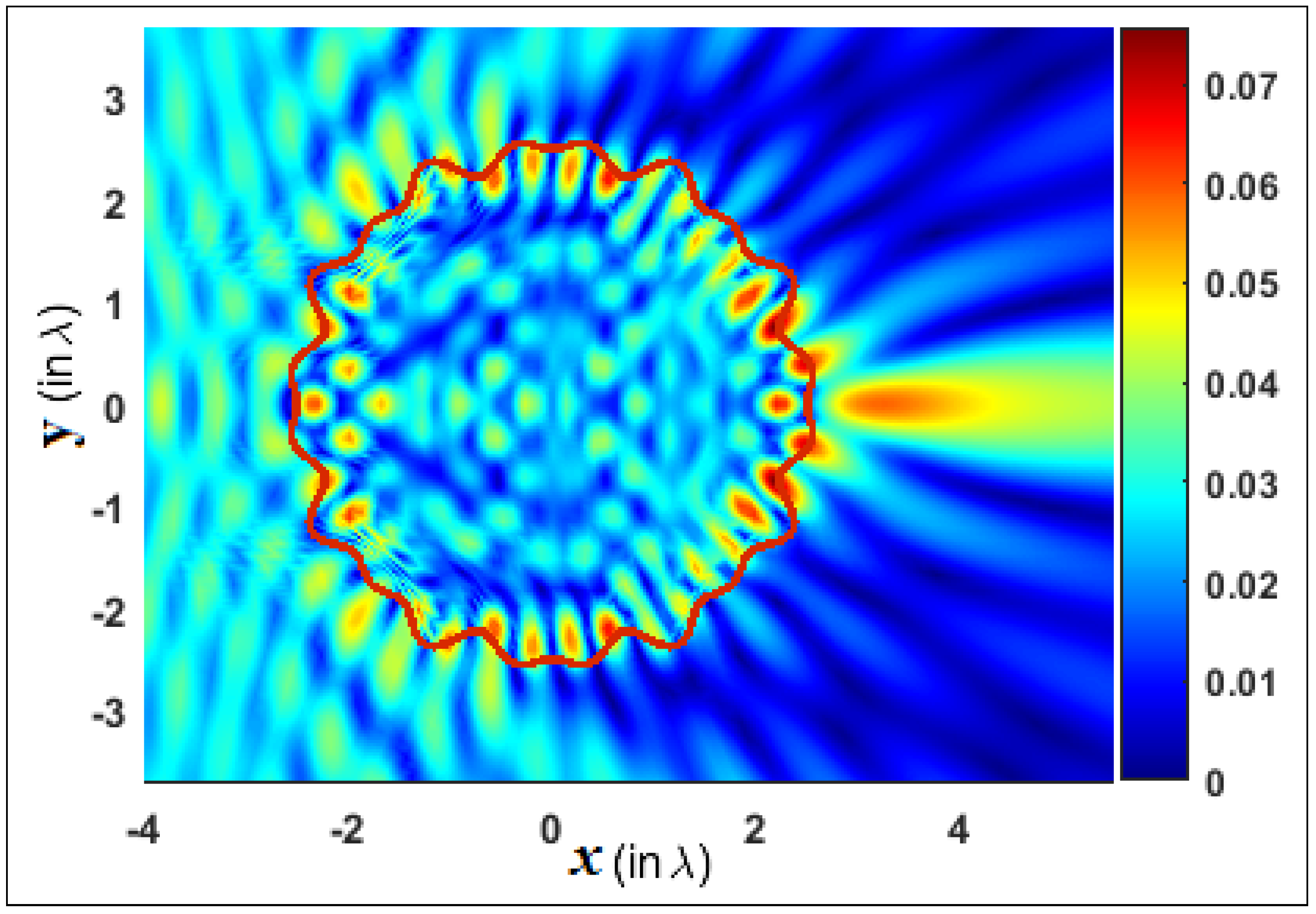Photonic Nanojets and Whispering Gallery Modes in Smooth and Corrugated Micro-Cylinders under Point-Source Illumination
Abstract
1. Introduction
2. Definition of the Computational Problem
3. Illumination of Cylinders of Constant Radii
4. Illumination of Corrugated Cylinders
5. Conclusions
Author Contributions
Funding
Conflicts of Interest
References
- Benincasa, D.S.; Barber, P.W.; Zhang, J.-Z.; Hsieh, W.-F.; Chang, R.K. Spatial distribution of the internal and near-field intensities of large cylindrical and spherical scatterers. Appl. Opt. 1987, 26, 1348–1356. [Google Scholar] [CrossRef] [PubMed]
- Luk’yanchuk, B.S.; Paniagua-Domínguez, R.; Minin, I.; Minin, O.; Wang, Z. Refractive index less than two: Photonic nanojets yesterday, today and tomorrow [Invited]. Opt. Mater. Express 2017, 7, 1820–1847. [Google Scholar] [CrossRef]
- Geints, Y.E.; Zemlyanov, A.A.; Panina, E.K. Photonic jets from resonantly excited transparent dielectric microspheres. J. Opt. Soc. Am. B 2012, 29, 758–762. [Google Scholar] [CrossRef]
- Chen, Z.; Taflove, A.; Backman, V. Photonic nanojet enhancement of backscattering of light by nanoparticles: A potential novel visible-light ultramicroscopy technique. Opt. Express 2004, 12, 1214–1220. [Google Scholar] [CrossRef]
- Heifetz, A.; Huang, K.; Sahakian, A.V.; Li, X.; Taflove, A.; Backman, V. Experimental confirmation of backscattering enhancement induced by a photonic jet. Appl. Phys. Lett. 2006, 89, 221118. [Google Scholar] [CrossRef]
- Kim, M.-S.; Scharf, T.; Mühlig, S.; Rockstuhl, C.; Herzig, H.P. Engineering photonic nanojets. Opt. Express 2011, 19, 10206–10220. [Google Scholar] [CrossRef]
- Wang, Z.; Guo, W.; Li, L.; Luk’yanchuk, B.; Khan, A.; Liu, Z.; Chen, Z.; Hong, M. Optical virtual imaging at 50 nm lateral resolution with a white-light nanoscope. Nat. Commun. 2011, 2, 218. [Google Scholar] [CrossRef]
- Dantham, V.R.; Bisht, P.B.; Namboodiri, C.K.R. Enhancement of Raman scattering by two orders of magnitude using photonic nanojet of a microsphere. J. Appl. Phys. 2011, 109, 103103. [Google Scholar] [CrossRef]
- Kong, S.-C.; Sahakian, A.; Taflove, A.; Backman, V. Photonic nanojet-enabled optical data storage. Opt. Express 2008, 16, 13713–13719. [Google Scholar] [CrossRef]
- Heifetz, A.; Kong, S.-C.; Sahakian, A.V.; Taflove, A.; Backman, V. Photonic nanojets. J. Comput. Theor. Nanosci. 2009, 6, 1979–1992. [Google Scholar] [CrossRef]
- Wang, H.; Zhang, J.; Wu, X.; Shen, D. On-resonance photonic nanojets for nanoparticle trapping. Opt. Express 2019, 27, 8. [Google Scholar]
- Mahariq, I.; Kurt, H.; Tarman, H.I.; Kuzuoglu, M. Photonic nanojet analysis by spectral element method. IEEE Photonics J. 2014, 6, 1–14. [Google Scholar] [CrossRef]
- Mahariq, I.; Kurt, H. On and off optical resonance dynamics of dielectric micro-cylinders under plane wave illumination. J. Opt. Soc. Am. B 2015, 32, 1022–1030. [Google Scholar] [CrossRef]
- Yang, J.; Twardowski, P.; Gerard, P.; Duo, Y.; Fontaine, J.; Lecler, S. Ultra-narrow photonic nanojets through a glass cuboid embedded in a dielectric cylinder. Opt. Express 2018, 26, 4. [Google Scholar] [CrossRef] [PubMed]
- Mahariq, I.; Kurt, H. Strong field enhancement of resonance modes in dielectric microcylinders. J. Opt. Soc. Am. B 2016, 33, 656–662. [Google Scholar] [CrossRef]
- Mahariq, I.; Astratov, V.; Kurt, H. Persistence of photonic nanojet formation under the deformation of circular boundary. J. Opt. Soc. Am. B 2016, 33, 535–542. [Google Scholar] [CrossRef]
- Mahariq, I.; Giden, I.H.; Kurt, H.; Minin, O.V.; Minin, I.V. Strong electromagnetic field localization near the surface of hemicylindrical particles. Opt. Quant. Electron. 2018, 50, 423. [Google Scholar] [CrossRef]
- Dong, A.; Su, C. Analysis of a photonic nanojet assuming a focused incident beam instead of a plane wave. J. Opt. 2014, 16, 125001. [Google Scholar] [CrossRef]
- Salhi, M.; Evans, P.G. Photonic Nanojet as a Result of a Focused Near-Field Diffraction. J. Opt. Soc. Am. B 2019, 36, 1031. [Google Scholar] [CrossRef]
- Mahariq, I.; Eti, N.; Kurt, H. Engineering Photonic Nanojet Generation; Computational Electromagnetics International Workshop (CEM): Izmir, Turkey, 2015; pp. 1–4. [Google Scholar]
- Minin, I.V.; Liu, C.-Y.; Geints, Y.E.; Minin, O.V. Recent Advances in Integrated Photonic Jet-Based Photonics. Photonics 2020, 7, 41. [Google Scholar] [CrossRef]
- Minin, I.V.; Minin, O.V.; Geints, Y.E. Localized EM and photonic jets from non-spherical and non-symmetrical dielectric mesoscale objects: Brief review. Annalen der Physik 2015, 527, 491–497. [Google Scholar] [CrossRef]
- Bonakdar, A.; Rezaei, M.; Brown, R.L.; Fathipour, V.; Dexheimer, E.; Jang, S.J.; Mohseni, H. Deep-UV microsphere projection lithography. Opt. Lett. 2015, 40, 2537–2540. [Google Scholar] [CrossRef] [PubMed]
- Bonakdar, A.; Rezaei, M.; Dexheimer, E.; Mohseni, H. High-throughput realization of an infrared selective absorber/emitter by DUV microsphere projection lithography. Nanotechnology 2015, 27, 3. [Google Scholar] [CrossRef] [PubMed]
- Biccari, F.; Hamilton, T.; Ristori, A.; Sanguinetti, S.; Bietti, S.; Gurioli, M.; Mohseni, H. Quantum dots luminescence collection enhancement and nanoscopy by dielectric microspheres. Particle Particle Syst. Charact. 2020, 37, 1900431. [Google Scholar] [CrossRef]
- Darafsheh, A.; Bollinger, D. Systematic study of the characteristics of the photonic nanojets formed by dielectric microcylinders. Opt. Commun. 2017, 402, 270–275. [Google Scholar] [CrossRef]
- Darafsheh, A. Influence of the background medium on imaging performance of microsphere-assisted super-resolution microscopy. Opt. Lett. 2017, 42, 735–738. [Google Scholar] [CrossRef]
- Darafsheh, A.; Guardiola, C.; Palovcak, A.; Finlay, J.C.; Cárabe, A. Optical super-resolution imaging by high-index microspheres embedded in elastomers. Opt. Lett. 2015, 40, 5–8. [Google Scholar] [CrossRef]
- Gérard, D.; Devilez, A.; Aouani, H.; Stout, B.; Bonod, N.; Wenger, J.; Popov, E.; Rigneault, H. Efficient excitation and collection of single-molecule fluorescence close to a dielectric microsphere. J. Opt. Soc. Am. B 2009, 26, 1473–1478. [Google Scholar] [CrossRef]
- Devilez, A.; Bonod, N.; Wenger, J.; Gérard, D.; Stout, B.; Rigneault, H.; Popov, E. Three-dimensional subwavelength confinement of light with dielectric microspheres. Opt. Express 2009, 17, 2089–2094. [Google Scholar] [CrossRef]
- Chongchang, Y.; Cheng, Q.; Wen, Z.; Yue, W.; Huaping, W. The design and manufacture of profiled multi-channeled hollow polyester fibers. Fibers Polym. 2009, 10, 657–661. [Google Scholar]
- Podrazký, O.; Kašík, I.; Peterka, P.; Aubrecht, J.; Cajzl, J.; Proboštová, J.; Matějec, V. Preparation of optical fibers with non-circular cross section for fiber lasers and amplifiers. Proc. SPIE 2015, 9450, 94501A. [Google Scholar]
- Gong, S.-H.; Ko, S.-M.; Jang, M.-H.; Cho, Y.-H. Giant Rabi splitting of whispering gallery polaritons in GaN/InGaN core-shell wire. Nano Lett. 2015, 15, 4517–4524. [Google Scholar] [CrossRef] [PubMed]
- Xu, C.; Dai, J.; Zhu, G.; Zhu, G.; Lin, Y.; Li, J.; Shi, Z. Whisperinggallery mode lasing in ZnO microcavities. Laser Photonics Rev. 2014, 8, 469–494. [Google Scholar] [CrossRef]
- Zhou, S.; Deng, Y.; Zhou, W.; Yu, M.; Urbach, H.P.; Wu, Y. Effects of Whispering Gallery Mode in Microsphere Super-Resolution Imaging. Appl. Phys. B 2017, 123, 9. [Google Scholar] [CrossRef]
- Mehdizadeh, O.Z.; Paraschivoiu, M. Investigation of a twodimensional spectral element method for Helmholtz’s equation. J. Comput. Phys. 2003, 189, 111–129. [Google Scholar] [CrossRef]
- Lee, J.; Xiao, T.; Liu, Q.H. A 3-D spectral-element method using mixed-order curl conforming vector basis functions for electromagnetic fields. IEEE Trans. Microw. Theory Tech. 2006, 54, 4141–4148. [Google Scholar] [CrossRef]
- Mahariq, I.; Kuzuoğlu, M.; Tarman, H.I. On the attenuation of perfectly matched layer in electromagnetic scattering problems with spectral element method. Appl. Comput. Electromagn. Soc. J. 2014, 29, 701–710. [Google Scholar]
- Mahariq, I.; Kurt, H.; Kuzuoğlu, M. Questioning degree of accuracy offered by the spectral element method in computational electromagnetics. Appl. Comput. Electromagn. Soc. J. 2015, 30, 698–705. [Google Scholar]
- Mahariq, I.; Erciyas, A. A spectral element method for the solution of magnetostatic fields. Turk. J. Elec. Eng. Comp. Sci. 2017, 25, 2922–2932. [Google Scholar] [CrossRef]
- Mahariq, I. On the application of the spectral element method in electromagnetic problems involving domain decomposition. Turk. J. Elec. Eng. Comp. Sci. 2007, 25, 1059–1069. [Google Scholar] [CrossRef]







© 2020 by the authors. Licensee MDPI, Basel, Switzerland. This article is an open access article distributed under the terms and conditions of the Creative Commons Attribution (CC BY) license (http://creativecommons.org/licenses/by/4.0/).
Share and Cite
Mahariq, I.; Abdeljawad, T.; Karar, A.S.; Alboon, S.A.; Kurt, H.; Maslov, A.V. Photonic Nanojets and Whispering Gallery Modes in Smooth and Corrugated Micro-Cylinders under Point-Source Illumination. Photonics 2020, 7, 50. https://doi.org/10.3390/photonics7030050
Mahariq I, Abdeljawad T, Karar AS, Alboon SA, Kurt H, Maslov AV. Photonic Nanojets and Whispering Gallery Modes in Smooth and Corrugated Micro-Cylinders under Point-Source Illumination. Photonics. 2020; 7(3):50. https://doi.org/10.3390/photonics7030050
Chicago/Turabian StyleMahariq, Ibrahim, Thabet Abdeljawad, Abdullah S. Karar, Shadi A. Alboon, Hamza Kurt, and Alexey V. Maslov. 2020. "Photonic Nanojets and Whispering Gallery Modes in Smooth and Corrugated Micro-Cylinders under Point-Source Illumination" Photonics 7, no. 3: 50. https://doi.org/10.3390/photonics7030050
APA StyleMahariq, I., Abdeljawad, T., Karar, A. S., Alboon, S. A., Kurt, H., & Maslov, A. V. (2020). Photonic Nanojets and Whispering Gallery Modes in Smooth and Corrugated Micro-Cylinders under Point-Source Illumination. Photonics, 7(3), 50. https://doi.org/10.3390/photonics7030050





